What is Winbox and How to Use it
To run MikroTik RouterOS, you need to know What is Winbox and How to Use it. It is a small utility that enables you to administer MikroTik RouterOS and monitor its progress. Winbox uses a fast and simple GUI and is what you can use to configure your router. While it is a native win32 binary, you can run it on Linux and macOS. Since all Winbox interface functions are as close as possible mirroring the console functions, you can find no Winbox sections in the manual. Using Winbox would not help you in system configuring like MAC address change on an interface Winbox changelog.
So, what is possible with Winbox? Join us with this article, to see what Winbox is and how to use it. Before that, for the purposes of Routing, Tunneling, Firewall, and networking you can buy MikroTik VPS. Winbox is available for free download from the MikroTik website.
Tutorial What is Winbox and How to Use it
If you are looking for a native program to administer your MikroTik RouterOS in a simple and quick way, Winbox is what you need. Winbox is used to monitor traffic across all traffic streams in real time and also to upload and download files to/from routers. As a graphical user interface, Winbox allows you to configure and manage MikroTik RouterOS devices.
This small program can be run on Linux and macOS using Wine. Previously, you read about installing Wine. It is possible to run Winbox on Linux by using Wine emulation software. Depending on your specific needs and objectives, the process of starting Winbox would be different. Make sure that the Microsoft font pack is installed, otherwise, you may see distortions. You need to consider the way you want to download the tool, install it on your device, and launch Winbox.
Two methods to start Winbox
As we mentioned, the Winbox loader is available on the MikroTik download page. Once you download the winbox.exe, you can see the loader winbox pop-up if you double-click on it. Then, you can see two different loader modes: Simple (Enabled by default) and Advanced.
1- Simple mode
As it is clear, the simple mode layout is ready to use when you open the mikrotik winbox loader for the first time like below.

You can enter the IP MAC address of the router, username, and password and click on the Connect button to be connected to the router. The port number can be entered after the IP address separating them with a colon. However, it is possible to change the port in the RouterOS services menu.
Note: As MAC session uses network broadcasts and is not 100% reliable, you are recommended to use an IP address whenever possible.
Now, let’s see how you can use neighbor discovery. Here is the Neighbor tab to view the list of available routers.
To connect to any of the routers of the below list, click on the IP or MAC address column. Keep in mind that, to use IP to connect, you need to click on the IP address, but to use the MAC address to connect, click on MAC address.
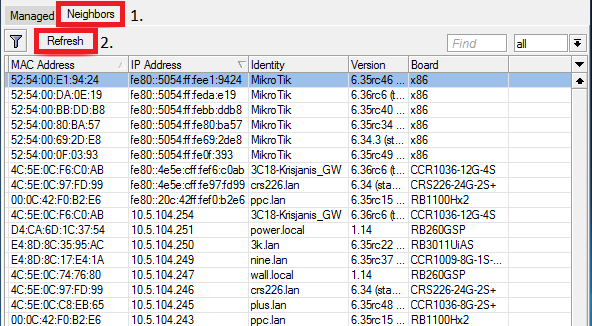
Also, the above neighbor discovery helps you find which devices are not compatible with Winbox. Devices that use CDP, like Cisco are some of them. So, connections will be established through a web browser, when you want to connect to a SwOS device.
So far, you learned what is Winbox and how to use it. To go through the details, let’s see how the buttons/check boxes work.
Here is the way you can use buttons and other fields of Winbox.
Connect: Connect to the router
Connect To RoMON: Connect to RoMON Agent
Add/set: Save/Edit any of the saved router entries in the Managed tab.
Open In New Window: Leaves loader open in the background and opens new windows for each device to which connection is made.
Connect To: destination IP or MAC address of the router.
Login: username used for authentication.
Password: password used for authentication.
Keep Password: if unchecked, the password is not saved to the list.
The next buttons you need to get familiar with are the options of Menu Items which include ”file” and ”tools”.
- File
New: Create a new managed router list in a specified location.
Open: Open managed router list file.
Save As: Save the current managed router list to a file.
Exit: Exit Winbox loader.
- Tools
Advanced Mode: Enables/Disables advanced mode view
Import: Imports saved session file
Export: Exports saved session file
Move Session Folder: Change the path where session files are stored
Clear cache: Clear Winbox cache
Check For Updates: Check for updates for the Winbox loader.
2- Advanced mode
To use additional Winbox loader parameters, an advanced mode must be enabled with Tools → Advanced Mode:
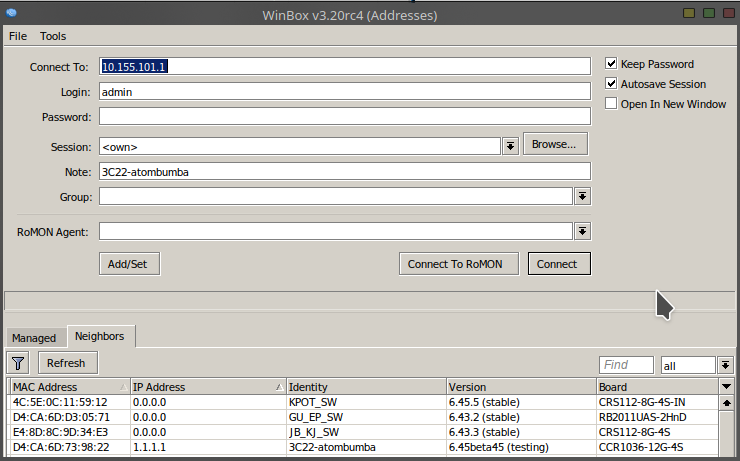
As you learned to work with Simple Mode, let’s review the buttons/checkboxes and other Fields of Advanced Mode to help you start using the revealed parameters.
- Buttons/check boxes
Browse: Browse the file directory for some specific session
Keep Password: If unchecked, the password is not saved to the list
Secure mode: If checked, Winbox will use DH-1984 for key exchange and modified and hardened RC4-drop3072 encryption to secure the session.
Autosave session: Saves sessions automatically for devices to which connections are made.
- Fields
Session: Saved router session.
Note: Note that is assigned to save router entry.
Group: Group to which saved router entry is assigned.
RoMON Agent: Select RoMON Agent from the available device list.
Tip: Although the managed routers list is encrypted, it can still be loaded in other Winbox without problems IF the master password is not set for it.
How to use Winbox with Command Line
The Winbox interface makes it far easier to manage and configure the Mikrotik RouterOS than a command line interface, but it is possible to use the command line to pass connect to, user and password parameters automatically.
winbox.exe [<connect-to> [<login> [<password>]]]For instance, to connect to router 10.5.101.1 with user “admin” without a password:
winbox.exe 10.5.101.1 admin ""It is possible to use the command line to pass connect to, the user, and password parameters automatically to connect to the router through RoMON. In this case, RoMON Agent must be saved on the Managed routers list so Winbox would know the user and password for this device:
winbox.exe --romon [<romon-agent> [<connect-to> [<login> [<password>]]]]For example to router D4:CA:6D:E1:B5:7D through 10.5.101.1 RoMON Agent with user “admin” without a password:
winbox.exe --romon 10.5.101.1 D4:CA:6D:E1:B5:7D admin ""How to use Winbox; IPv6 connectivity
you are reading this article to find out What is Winbox and How to Use it. According to this guide, you know how to start winbox and use Simple and Advanced Mode. In this part, IPv6 connectivity will be discussed.
Winbox supports IPv6 connectivity. As you see in the following example, to connect to the router’s IPv6 address, it must be placed in square braces the same as in web browsers when connecting to the IPv6 server.
Keep in mind that most of the network drivers will not enable IP stack unless your host device has an IP configuration. So, you need to set IPv4 configuration on your host device.
[2001:db8::1]
when connecting to the link-local address interface index must be entered after the %:
[fe80::a00:27ff:fe70:e88c\%2]
Port number is set after the square brace when it is necessary to connect Winbox to another port than the default:
[fe80::a00:27ff:fe70:e88c\%2]:8299
Winbox neighbor discovery is capable of discovering IPv6-enabled routers. There are two entries for each IPv6-enabled router, one entry is with an IPv4 address and another one with IPv6 link-local address. You can easily choose which one you want to connect to.
How to Run Winbox on macOS
Since Apple has removed support for 32-bit applications after macOS 10.15Catalina started, it is not possible to use regular Wine and regular Winbox in this OS. Wine has made available a 64-bit version for macOS, and MikroTik has released a special Winbox64.exe version as well.
There are two steps required to run Winbox64 which are explained in the following:
- Install the latest Wine from the Wine macOS builds page (wine-devel-7.X-osx64.tar.xz) and make sure you have downloaded the winbox64.exe executable from the MikroTik download page.
- Launch Winbox64.exe with “open file with” > Wine64.app
How to use Winbox Interface
To continue discovering What is Winbox and How to use it, it is time to talk about Winbox Interface Overview. As you know, it is designed to be intuitive for most users. But what are the consists of the interface?
- The main toolbar at the top where users can add various info fields, like CPU and memory usage.
- The menu bar on the left – list of all available menus and sub-menus. This list changes depending on what packages are installed. For example, if the IPv6 package is disabled, then the IPv6 menu and all its sub-menus will not be displayed.
- Work area – an area where all menu windows are opened.
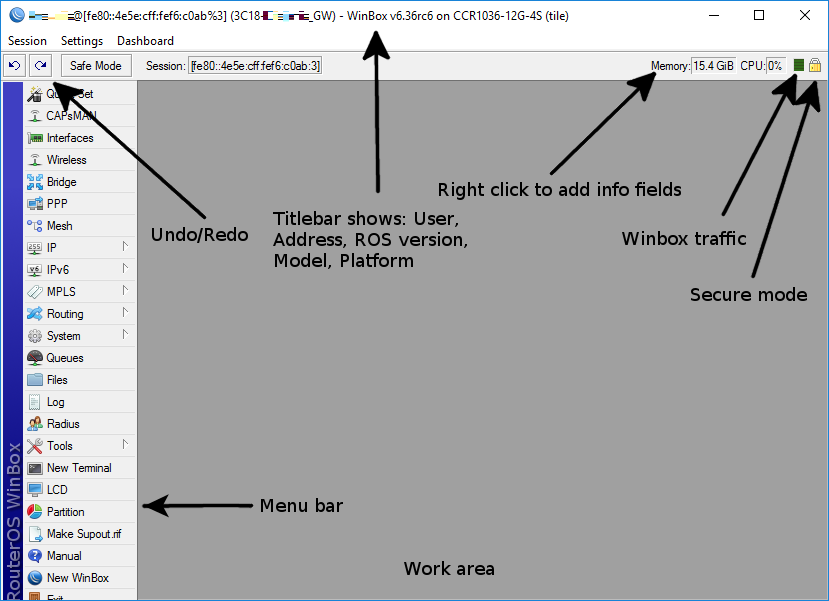
The title bar shows information to identify with which router the Winbox session is opened. Information is displayed in the following format:
[username]@[Router's IP or MAC] ( [RouterID] ) - Winbox [ROS version] on [RB model] ([platform])How to use Winbox MDI interface (Child Windows)
In this section, we are going to learn about the work area and child windows. Winbox has an MDI interface. So, all menu configuration windows are attached to the main Winbox windows. This is how it works:
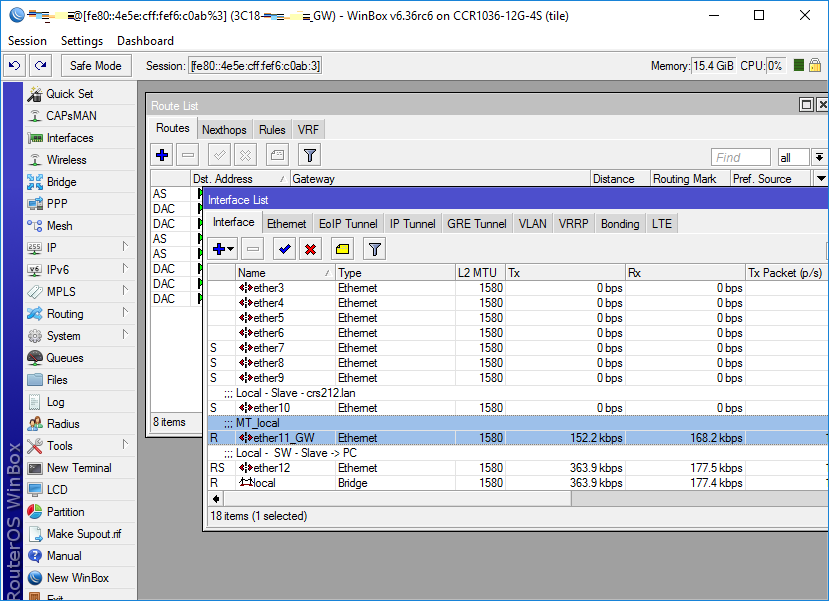
While the child windows cannot be dragged out of the working area, the Interface window is dragged out of the visible working area and a horizontal scroll bar appeared at the bottom in the screenshot above. If any window is outside visible work area boundaries the vertical or/and horizontal scrollbars will appear.
Child window menu bar
To go through the details, let’s review the child window menu bar. Each child window has its own toolbar. Most of the windows have the same set of toolbar buttons:
Add: Add a new item to the list.
Remove: Remove the selected item from the list.
Enable: Enable selected item (the same as enable command from console)
Disable: Disable selected item (the same as disable command from console)
Comment: Add or edit a comment.
Sort: Allows sorting out items depending on various parameters.
Almost all windows have a quick search input field on the right side of the toolbar. Any text entered in this field is searched through all the items and highlighted as illustrated in the screenshot below:
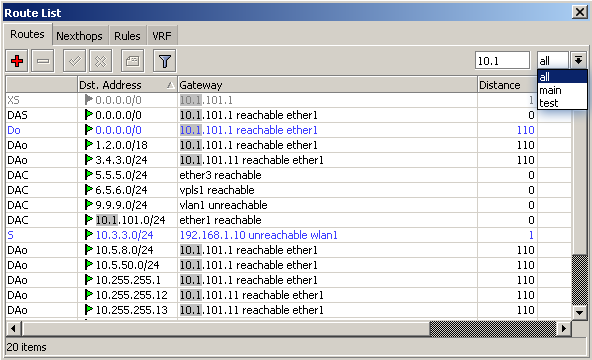
To sort out items by routing tables quickly for the currently opened (IP Route) window, you can use the drop-down box which is on the right side next to the quick find input field.
For example, if the main is selected, then only routes from the main routing table will be listed. A similar drop-down box is also in all firewall windows to quickly sort out rules by chains.
How to sort out displayed items
As it is clear, every window has a Sort button. When clicking on this button several options appear as illustrated in the screenshot below.
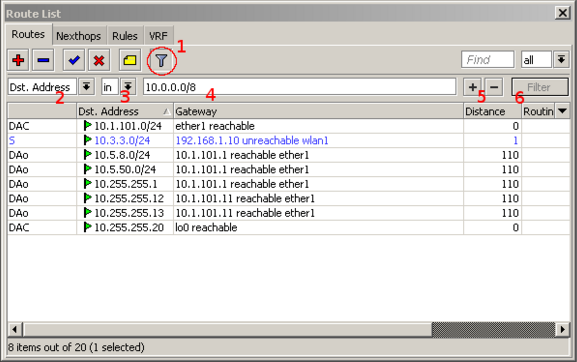
To filter out routers quickly, look at the example below in the 10.0.0.0/8 range.
- Press the Sort button.
- Chose Dst.Address from the first drop-down box.
- Chose in form the second drop-down box. “in” means that the filter will check if the DST address value is in range of the specified network.
- Enter the network against which values will be compared (in our example enter “10.0.0.0/8”)
- These buttons are to add or remove another filter to the stack.
- Press the Filter button to apply our filter.
Clearly, the Winbox sorted out only routes that are within the 10.0.0.0/8 range. You may find different comparison operators (Number 3) for each window. Other windows may have operators such as “is not”, “contains”, and “contains not”.
Since Winbox enables you to build a stack of filters, it is possible to filter by destination address and gateway:
- Set the first filter as described in the example above.
- Press the [+] button to add another filter bar in the stack.
- Set up a second filter to filter by the gateway.
- Press the Filter button to apply filters.
By clicking [-], you may also remove pointless filters from the stack.
How to customize the list of displayed columns
Winbox by default displays the settings that are most frequently used. However, in some cases, it’s necessary to view other parameters, such as “BGP AS Path” or other BGP properties, to check that the right routes are being chosen. Winbox allows customizing displayed columns for each individual window. For example to add BGP AS path column:
- Click on the little arrow button (1) on the right side of the column titles or right-mouse-click on the route list.
- From popped up menu move to Show Columns (2) and from the sub-menu pick the desired column, in our case click on BGP AS Path (3).
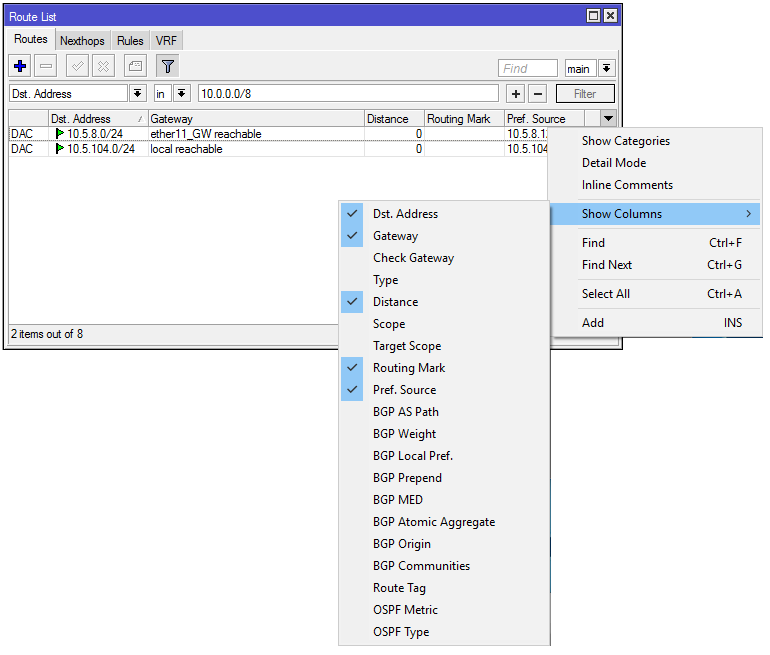
When changes are made to the window layout, they are remembered, and the same column size and order are used the next time Winbox is launched.
Detail Mode
You can also make Detail mode available. In this mode, all parameters are displayed in columns, with the parameter name appearing in the first column and the parameter value appearing in the second.
Right-click the item list with the mouse and select Detail mode from the popup menu to enable detail mode. Right-click the item list with the mouse and select Detail mode from the popup menu to enable detail mode.

Category View
Items may be categorized in a list. All items will be arranged alphabetically or according to a different category in this mode. For instance, if objects are sorted by name, they can be categorized alphabetically. Items can also be categorized by kind, as shown in the screenshot below.
Right-click the item list with your mouse and select “Category View” from the pop-up menu to enable it. Show Categories.
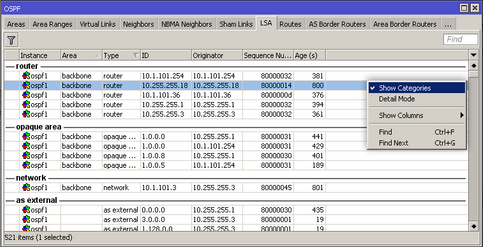
Using Winbox’s drag-and-drop capabilities, it is possible to upload and download files to and from the router. By clicking the file with the right mouse button and choosing “Download,” you can also download it.
Notice: Drag & Drop works if Winbox is running on Linux using wine4. Drag and drop between two Winbox windows may fail.
Traffic monitoring
Winbox is a tool that is used to continuously track all interface, queue, and firewall rule traffic. Monitoring graphs for Ethernet traffic are displayed in the screenshot below.
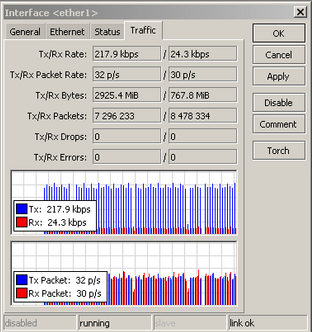
This demonstrates how simple it is to replicate a Winbox item. In this example, we’ll show you how to convert a dynamic PPPoE server interface into a static interface by pressing the COPY button.
This image displays the starting state, as you can see, the DR stands for dynamic.
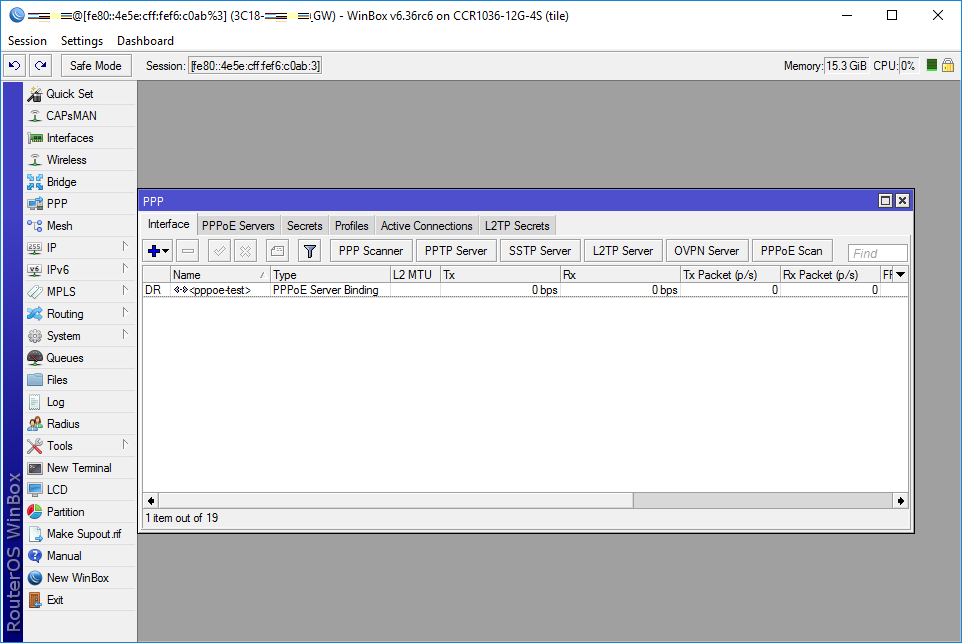
Double-Click on the interface and click on COPY:

There will be a new interface window and an automated creation of a new name (in this case pppoe-in1)

So, Down/Up event this interface will be Static:

Transferring Settings
- Managed router transfer
In the File menu, use Save As and Open functions to save the managed router list to a file and open it up again on a new workstation.
- Router sessions transfer
In the Tools menu, use the Export and Import functions to save existing sessions to file and import them again on a new workstation.
How to solve: '(port 20561) timed out' error? It was shown when connecting to routers mac address.
Windows (7/8) does not allow mac connection if file and print sharing is disabled.
Conclusion
In this article, you learned What is Winbox and How to use it. Now, you know how to start Winbox. There are two different ways to start Winbox including Simple and Advanced. Whether you prefer GUI, command line, Linux, or macOS, Winbox will be comfortable for you. This guide explained how you can use Winbox in each of them. Configuring the Winbox MDI interface was also taught which is interesting for parents.
If you encounter any problems, please do not hesitate to contact us. Our technical support team will try their best to solve your problems.
I can not get birr, So what shall l do ?
Dear Ayto, we are not sure what you mean by ‘birr.’ Are you having trouble downloading Winbox, connecting to your router with it, or something else?